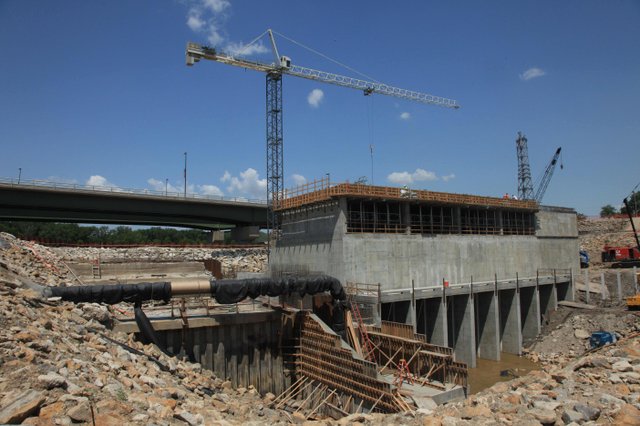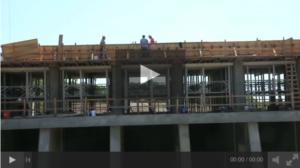
Sarah Hill-Nelson stands 30 feet below the Kansas River and knocks on wood.
A new Hydroelectric Plant is being built for Bowrersock Mills and Power on the north side of the Kansas River. The new plant will produce more clean energy than the older plant across the river.
Not that wood is easily found. Here on the north bank of the Kaw, Hill-Nelson is surrounded by concrete, it seems. But mention the mild Kansas spring that has kept the waters of the Kaw manageable, and she finds a 2-by-4 to rap. Talk of how this massive, $25 million hydroelectric power plant project has defied the odds to stay on schedule, and she finds a wooden form to touch.
Down here in the depths of the Kansas River, though, concrete just dominates the place. Hill-Nelson stands in something that some would say resembles a three-sided concrete tomb. Near her feet are four empty pits in a concrete floor. Soon enough the pits will house turbines. Two are new from China. But the two that Hill-Nelson gushes about came out of a 1930s hydroelectric power plant in Maine.
“We actually have all the operator’s notes from the 1930s,” Hill-Nelson says with an excitement only someone who grew up in a hydroelectric power plant could muster.
Down here, her voice — and her excitement, too — echoes. At her back is a concrete wall whose thickness is measured in feet, not inches. About 30 feet above her head is a solid concrete ceiling. Staring upward at the ceiling is when it really hits you that soon, the top of the Kansas River will cover this.
That’s why Hill-Nelson urges all those motorists who cross the downtown Kansas River bridges to get a good look. Crews are 12 months into constructing a new hydroelectric power plant for her family’s Bowersock Mills & Power Co. For decades, motorists will drive over the Kansas River bridges and wonder how this plant works and what lurks beneath the surface of the Kaw.
Folks can see it clearly now. Eight open chambers, wide and tall ready to be filled with water. Come December, if the project stays on schedule, crews will remove the coffer dams that keep the water at bay today. Hill-Nelson tries not to think of the day when water will fill these chambers. Tries not to think of the day when her family, descendants of the man who finally figured out how to dam the Kaw in the late 1800s, can throw the switch on this new plant.
“It makes me too nervous,” Hill-Nelson says. “I just keep saying we have to get through today.”
But the day will come. The waters will rise, the turbines will turn, and the view will disappear. The bottom of the Kansas River will once again be what river bottoms are meant to be: a mystery.
“Hopefully,” Hill-Nelson says as she stands under the Kansas River bridge and looks at the dry land surrounding her hydroelectric plant, “folks will never see it this way again.”
Then she spins frantically, scanning the ground for a piece of scrap.
“Oh, touch wood, touch wood.”
•••
What will stand above the surface of the Kansas River, though, is on the mind of Hill-Nelson a lot these days. Simply put, it will be a tall building that grows out of the north bank of the Kaw.
“I’ve been to a lot of meetings and stood up and said ‘it’s going to be tall. Are your ready for a tall building?’” Hill-Nelson said.
The answer always has been yes, but now she’s fretting about what community members may think as construction crews keep adding levels. In the past, the building has been described as being a bit taller than the Kansas River bridges. But, perhaps “a bit” wasn’t the best description.
Hill-Nelson recently got out her calculator and did some figuring to provide specifics. When the building is completed, it will be about 48 feet taller than the top of the Kansas River levee. For motorists familiar with the steel tower directly east of the Kansas River bridge, that’s about how tall the building will be.
And it will get tall in a hurry. Hill-Nelson said crews are scheduled to start raising pre-fabricated concrete walls in July that will rapidly add to the height of the building.
“One day you will drive across the bridge and be like ‘Wow,’” Hill-Nelson said.
The building needs to be tall for a couple of reasons. The design requires that a 50-ton crane be stationed on the top floor of the building. The crane needs to be in place in order to do maintenance on the four turbines and generators, which each weigh about 40 tons.
The design also requires one entire story that is completely devoid of equipment, except for the long shafts that connect the turbines at the bottom of the plant to the generators at the top. The empty story is designed to allow floodwaters from the Kaw to simply flow through the building without damaging key equipment.
If water levels reach historic highs, Hill-Nelson said the plant will look like a little island on the Kaw, with nothing but its top story that houses the generators and the crane standing above the water.
Hill-Nelson is hoping that view doesn’t happen often. On most days, she said the building will look a bit like a drive-by classroom on hydroelectric power. The building, designed by Lawrence-based Sabatini Architects, will feature a glass story that allows passersby to see the inner workings of the plant and hypothesize about how the whole process works. People already are doing a lot of guessing about that.
“You can’t believe how many people stop me in the grocery store and asks how this is going to work,” Hill-Nelson said.
She’s betting the building will be a source of curiosity for decades to come.
“The plant certainly won’t be taller than the North Lawrence grain elevators or taller than City Hall, but as people come across the bridge, they are going to notice it,” Hill-Nelson said. “It definitely will be a skyline-changer.
“We hope it will become known as a signature building in Lawrence.”
•••

At about this time, Hill-Nelson could use an entire Redwood forest to knock upon. She’s talking about everything this power plant has to be designed to withstand. That includes sliding, tilting, floating and lots of other things you don’t want a $25 million building to do.
“Sometimes I panic about everything that could go wrong, but then I look across the river at the old powerhouse,” Hill-Nelson said. “They built that in 1905, and that brings my stress level down.”
The old powerhouse on the south bank of the Kansas River is a remnant of Justin D. Bowersock, Hill-Nelson’s great-great grandfather who used the mill to power a host of industrial businesses along the Kaw, ranging from a barbed wire factory to flour mills.
Hill-Nelson said the technology inside the two buildings will be remarkably similar. The process for using water to produce electricity hasn’t changed much in the last century. Constructing a building along the river, however, has.
The 1905 building relied on horses and mules to haul cut limestone to the site, while the new building project makes use of a crane and earth movers.
Both buildings follow the basic principle of digging a deep hole to find bedrock that can support the massive weight of the plant. But the new plant takes advantage of materials that would have been tough to muster in 1905. The floor that construction crews are working on will be three feet of solid concrete. Last week, crews were installing the last of 50 tons of rebar to reinforce the floor.
Employees with the project’s general contractor, Kansas City, Mo.-based Kissick Construction, do a lot of unique projects along rivers, but employees said this one has been memorable.
Employees tell how several community members frequently will stand for an hour or more on the Kansas River levee just to watch the construction process.
“And I admit, I’ve actually taken quite a few pictures,” said construction worker Steve Crews of Platte County, Mo. “My kids always want to know what I do. This is one I want them to see.”
Crews said he’ll be sad to see the project end, which gave him an idea that he shared with Hill-Nelson during a recent lunch break.
“You ought to build another one of these,” he said.
That’s not likely. The project has kept Hill-Nelson and her father, Stephen Hill, plenty busy. When completed the plant will produce enough electricity to power about 3,300 homes each day. The plant’s power supply already has been sold for the next 25 years to the Kansas City Kan. Board of Public Utilities, which will get to market the power as part of its portfolio of green energy.
Work is scheduled to be completed by the end of the year, which caused one recent visitor to ask whether Hill-Nelson already had started planning a ribbon cutting for the project. Would she have a large party for the public? Not one, she replied.
“I think,” she said, “we’re going to have a series of parties when we’re done with this.”
Touch wood.
Source: LJWorld.com. May 29, 2012
